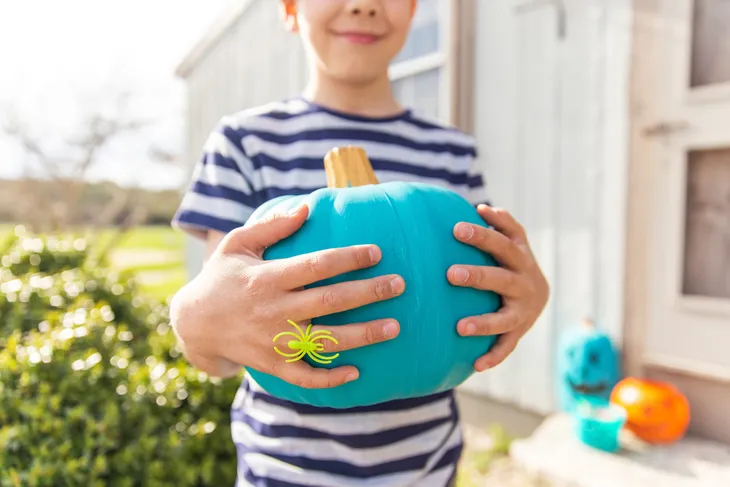- Halloween is often associated with loads of sugary treats which can be a challenge for people living with diabetes.
- Luckily, there are simple things you can do to still enjoy the holiday while managing your blood sugar.
- Plus, candy doesn’t have to be the center focus of the holiday, there are other ways to celebrate too!
Many people associate Halloween with loads of candies and chocolates which can be a serious nightmare for someone living with diabetes. Not to mention, it can make navigating the holiday stressful. Luckily there’s more to Halloween than just sugary treats and there are simple ways for someone living with diabetes to navigate it.
While sugary candies are certainly a part of Halloween, it doesn’t mean you or your child have to forgo celebrating the holiday altogether. Here are 12 tips to celebrate Halloween safely if you have diabetes.
Can Children With Diabetes Go Trick-Or-Treating?
While trick-or-treating is mostly about collecting loads of candy, there is more to it. For starters, it’s a chance for your child to dress up and spend time and have fun with their friends or family. Not to mention, going door to door can be great exercise. So, the American Diabetes Association says trick-or-treating doesn’t have to be off-limits for children with diabetes.
The source also says diabetes “shouldn’t affect your children from having regular childhood experiences.” It’s all about how you prepare ahead of the event and the expectations and boundaries you set together.
Plan Ahead
One very important step in having a healthy and happy Halloween is planning ahead. Involving your child in the planning of the event will help teach them how to navigate other holidays in the future.
Though they don’t have to miss out on Halloween, planning can help them stay safe. For starters, it’s a good idea to not snack on candy while trick-or-treating. Instead, set clear rules that they can have some candy when they return home. That way you can help them figure out how much is safe to eat based on their blood sugar levels.
The American Diabetes Association says that having some candy can be a good thing because “completely restricting anything makes it taboo and increases the chances of your child sneaking around to get it.” Take this opportunity to set boundaries and rules so your child knows what to expect ahead of the holiday. It’s also important to listen to them to find out what’s most important to them about Halloween.
Be a Part of the Teal Pumpkin Project
The Teal Pumpkin Project, created by the Food Allergy Research and Education (FARE) is an easy way to make trick-or-treating safe and inclusive for everyone. The source says 1 in 13 children are living with food allergies, intolerances, and conditions that make navigating Halloween a challenge. So how do you participate?
You can participate by handing out non-food treats, such as stickers, bookmarks, crayons, pencils, bubbles, playing cards, and any other fun trinkets. Let your trick-or-treaters know you’re participating in the project by placing a teal pumpkin on your front porch and one of their free printable signs on your front door. This lets the kids know you have non-food treats available. This project isn’t only great for children with allergies but it’s a great option for children living with diabetes too.
Tips for Adults With Diabetes Handing Out Candy
Halloween isn’t only a challenge for children with diabetes, it can be challenging for adults too. If you’re an adult and want to hand out candy for Halloween, then the American Diabetes Association says a simple hack is to give out candy you don’t like. This can help prevent temptation.
Another quick tip is to avoid purchasing Halloween candy until right before the holiday so you won’t be tempted to eat it beforehand. At the very least you can put it away in a cupboard. Out of sight, out of mind, right?
The source says if you don’t have children participating in the holiday then perhaps you can forgo giving out candy altogether. Instead, you can make your own Halloween traditions such as going out for dinner with a friend, going to a movie, or hosting a Halloween party with diabetes-friendly foods.
Offer Your Child a Trade
Trick-or-treating is all fun and games until your child comes home with a giant bag of candy. But the American Diabetes Association says a simple way to bypass the temptation of eating all the candy is to offer your child a trade.
The source suggests “buying” their candy with cash and allowing them to pick out their toys or games. Alternatively, you can purchase toys ahead of the holiday and offer a direct trade when they get home. This tip should also be looped into our first tip, which is planning ahead. Informing your child that they can trade their candy after trick-or-treating can help them know what to expect and they may even be excited to do so.
Use the Candy for Future Blood Sugar Lows
Anyone with diabetes knows how important it is to monitor their blood sugar. And blood sugar lows (hypoglycemia) can and do happen, whether it’s from not eating enough carbs, taking too much of the hormone that regulates glucose in the body, or from the amount and timing of physical activity. Whatever the reason may be, you can consider using Halloween candy as a way to treat future blood sugar lows.
The American Diabetes Association suggests allowing your child to keep a handful of candy. The source says set chocolate aside as it isn’t as helpful for sugar lows and encourage your child to pick out the pure sugar candies they like. Diabetes Canada then suggests dividing these candies into servings of 15-grams of carbohydrates and putting them into individual bags so that the candy is ready to be eaten when a sugar low occurs.
Donate Extra Candy
After deciding which candies to keep, you can offer your child a trade for the rest. But what do you do with that extra candy that they aren’t going to eat? The American Diabetes Association suggests donating the extra candy to a children’s hospital. This way children who are too ill to participate in the holiday can still enjoy candy.
You can also encourage your child to be part of the donation and let them help you drop off their candy. Allowing them to partake in the donation allows them to see firsthand how they can help others in a small, simple way.
Practice Portion Control
Portion control can be hard but it’s important to understand your limits, especially when you have diabetes. Explaining to your child why they shouldn’t indulge in all their loot and the consequences it can have on their health can help them understand portion control.
You can do this by setting rules of how many pieces of candy they can eat each day, assuming their blood glucose isn’t already high. The American Diabetes Association says if you have other children that don’t have diabetes, you should have each child follow the same rules so no one feels left out. Plus practicing moderation with sugary treats is good for everyone’s health whether you have diabetes or not. This is also a great opportunity to focus on other elements of the holiday.
Read Nutrition Labels and Enjoy Strategically
In addition to practicing portion control, it’s also important to read nutrition labels. Finding out how many grams of sugar and carbs are in Halloween candy is an important step in managing your diabetes. Verywell Health explains that this can help you find a way to include the treats as a part of your meal or snack.
When you eat the treats is important too. The source says eating Halloween treats after having a balanced meal is one way you can help prevent a large sugar spike. Sharon Puello, RD, CDN, CDCES, registered dietitian and certified diabetes instructor also tells the source that it’s best to choose treats that aren’t just sugar. For example, chocolate with nuts is a better choice than a lollipop.
How to Celebrate Halloween At Home
While candy is certainly a big part of Halloween, it doesn’t have to steal the spotlight. There are tons of fun ways to celebrate Halloween that are diabetes-friendly.
For starters, you can host a Halloween party. Encourage guests to dress up! You could even have a costume contest and offer prizes for the most creative costumes. Hosting the party is also another great way to control the food and drinks. Swap out sugary treats for healthier (but still festive!) options. This way everyone will still enjoy the food, and individuals with diabetes won’t feel left out.
Carve Pumpkins
Another fun tradition of Halloween is carving pumpkins. This is yet another festive activity that isn’t focused on candy and it’s fun for the whole family.
You can make it a whole event by visiting a pumpkin patch and picking out the perfect pumpkins. Then encourage everyone to draw their designs on paper before carving the pumpkins. Don’t forget to save the pumpkin seeds! After carving your jack-o’-lanterns you can make roasted seeds together and then enjoy them with a Halloween movie to finish off the night.
Adults Need to Be Mindful of Cocktails
Festive cocktails are always fun, especially at parties but adults with diabetes need to be extra mindful. For starters, alcohol can affect your liver’s ability to regulate blood sugar. The liver will be occupied with removing alcohol from your blood instead of regulating your blood sugar. While this isn’t always a problem, Healthline says it can be if your blood glucose is already low.
Secondly, you’ll need to be mindful of the sugar. Many cocktails are mixed with sugary juices, syrups, or other mix-ins that can cause your blood sugar to spike. If you’re not hosting the Halloween party, consider bringing a diabetes-friendly cocktail to share. The best types of alcohol for adults with diabetes are drinks that are low in sugar and carbs.
Wear Your Medical ID
Medical identification can save your life. It provides important information about your health that first responders can use when you’re unable to communicate. WebMD says medical ID is especially important for individuals with diabetes because when your blood sugar drops too low, you may have difficulty talking or you may even become unconscious.
So with this in mind, make sure your child is wearing their medical ID before going trick-or-treating. If you have diabetes and plan on attending a Halloween party, it’s also important for you to wear your medical ID.
















